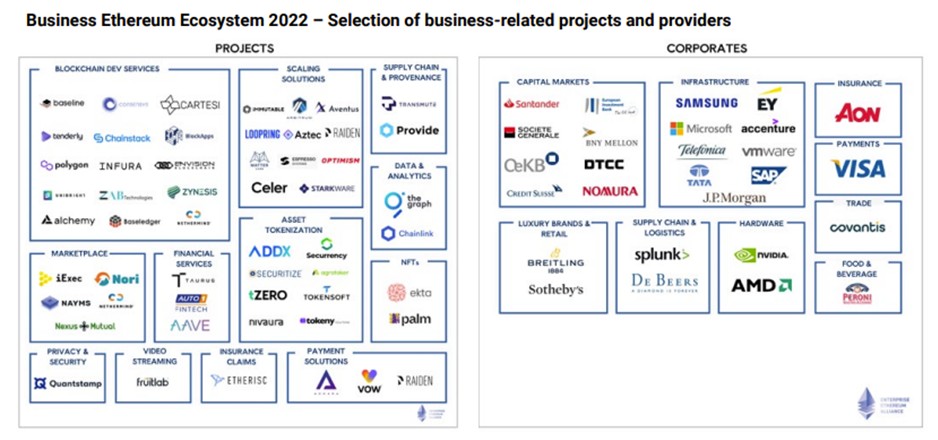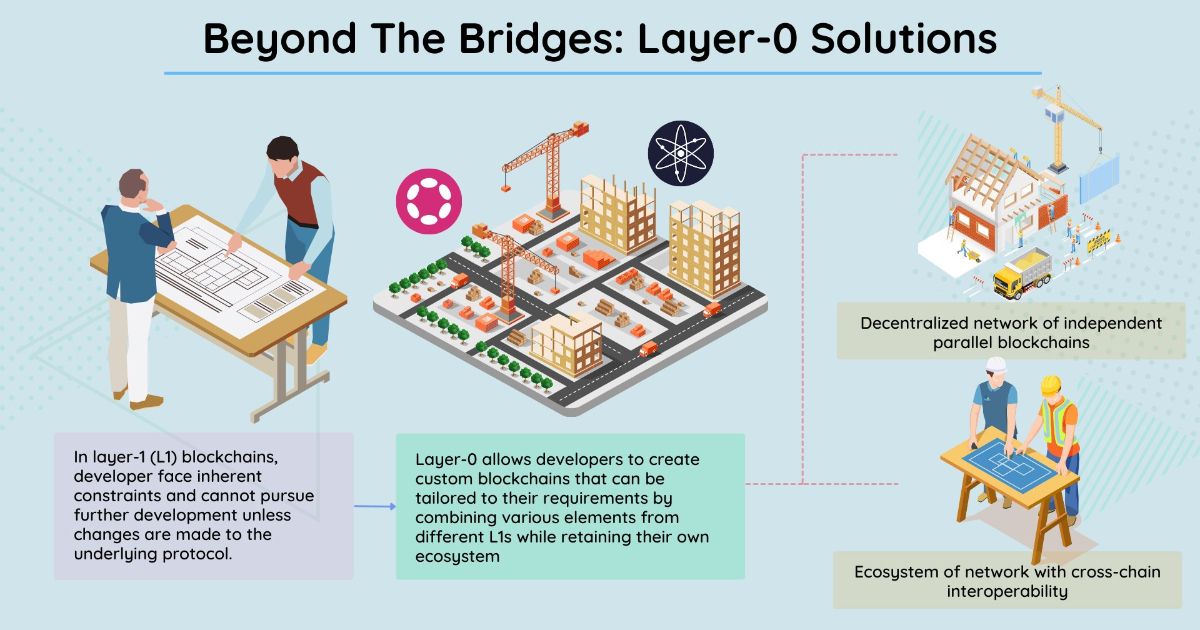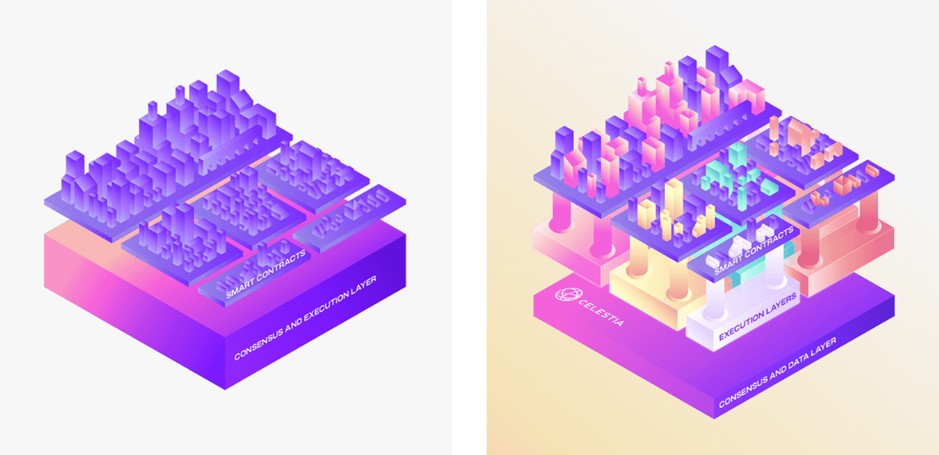Top Blockchain Trends: Enterprise, Cross-Chain, Modular and Privacy
Top Blockchain Trends: Enterprise, Cross-Chain, Modular and Privacy
.png)
Interest in blockchain technology is growing significantly as more platforms are emerging to overcome technical limitations and provide real-world applications. What are the top trends in blockchain technology? We’ve put up a list of emerging trends to watch in four categories: Enterprise, Cross-chain, Modular and Privacy platforms.
ENTERPRISE BLOCKCHAIN
An enterprise blockchain is a type of blockchain that businesses use to make their business processes more effective and secure. Enterprise blockchains are generally ‘permissioned’-the network owner directly control the network and decide who can use it and who can’t. As another major difference from public blockchains, enterprise blockchains focuses on scalability as businesses target to easily support more transactions.
Big brands and businesses including Meta (Facebook), Mastercard, IBM and Walmart are exploring to use enterprise blockchain technology to enhance their business and payment processes.
What are the Popular Enterprise Blockchains?
R3, Hyperledger, ConsenSys and Enterprise Ethereum Alliance are the major startups and organizations focusing on developing enterprise blockchain technology.
R3 is an enterprise blockchain software developer working with businesses and enterprises around the world. Through its proprietary blockchain technology Corda, R3 focuses on helping banks and regulated financial institutions to develop permissioned blockchain technology.
With the support from IBM and Intel, Hyperledger provides open-source technology tools for developers to build and deploy enterprise blockchains. Its major project is Hyperledger Fabric. Multiple brands and businesses are using it to build their own blockchain platforms for supply chain and shipping applications.
Software company ConsenSys is the developer of the popular blockchain wallet MetaMask and Ethereum blockchain infrastructure Infura. Its founder Joseph Lubin is also one of the co-founders of Ethereum. ConsenSys actively promotes Central Bank Digital Currency (CBDC), including cross-border payment technology solution with the Hong Kong Monetary Authority (HKMA).
The Enterprise Ethereum Alliance (EEA) aims to drive the adoption of Enterprise Ethereum blockchain technology among organizations and businesses. You can think of Enterprise Ethereum as a private variation of the Ethereum blockchain technology. EEA now has over 300 members around the globe, with Accenture, Intel and Microsoft, among others, as its founding members.

Blockchain projects and enterprises in Ethereum ecosystem in 2022. Source: Enterprise Ethereum Alliance.
CROSS-CHAIN PLATFORM
As the blockchain sector grows, many believe the future is multi-chain, with different blockchains networks acting like cities. This will enhance the importance of cross-chain functionality.
What is Cross-Chain Technology?
Cross-chain technology is offering an interface for different independent blockchains to communicate with each other. It enables the exchange of information, data, cryptocurrency or NFTs between blockchain networks. Popular blockchains Polkadot and Cosmos are the two leading platforms focusing on cross-chain functionality.
Polkadot: Multi-chain Blockchain
Polkadot is a multi-chain network aims to connect different blockchains, enabling them to transfer data and asset with each other. Polkadot achieves this through its “parachains” and Relay Chain structure. Different organizations and projects can create and control their parachains, which connect the Relay Chain, Polkadot’s main blockchain. And Relay Chain connects Polkadot to other blockchains with its cross-chain bridge feature.
Ethereum’s co-creator Gavin Wood launched the Polkadot blockchain project in 2020, and the platform is currently in a rollout phase. To stress-test Polkadot’s blockchain technology, the Kusama network is launched as the beta version of Polkadot. Kusama allows users to experiment with different technology applications on the Polkadot blockchain.
 Polkadot and Cosmos explained. Source: Twitter @eli5_defi
Polkadot and Cosmos explained. Source: Twitter @eli5_defi
Cosmos: The Internet of Blockchains
Cosmos positions itself as “the internet of blockchains” to enable blockchains to communicate with each other quickly and efficiently. Within Cosmos’ structure, Cosmos Hub serves as the key chain to connect different “zones”-independent chains. Through the inter-blockchain communication protocol (IBC), Cosmos enables data and value to pass freely between zones. Developers can connect blockchains to the Cosmos Hub using an open-source tool Cosmos SDK and grow a user base.
MODULAR BLOCKCHAIN
One major hurdle on blockchain adoption is its scalability-the capability of the network to handle large amounts of transaction data in a shot span of time. To tackle this issue, one new thesis is a single blockchain doesn’t need to handle all components on its own. This leads to the rise of modular blockchains.
What is Modular Blockchain?
A modular blockchain structure splits or even outsources different duties to one or more separate layers. The objective of this design is to achieve lower transaction fees without sacrificing decentralization and security of the blockchain network. This approach differs from “monolithic blockchains”-like Bitcoin and Ethereum-which handles three core duties: consensus, data availability and transaction execution.
Celestia: ‘Lazy’ Modular Blockchain
Celestia is the modular blockchain enabling developers to deploy a blockchain quickly without bootstrapping a new consensus network. This is like how cloud computing services launch new virtual servers.

Monolithic Blockchain versus Celestia Modular Blockchain. Source: Celestia Labs.
Previously known as ‘LazyLedger’, Celestia assumes the role of a consensus and data validation layer. By plugging in Celestia, developers can launch decentralized applications (dApps) on app-specific chains. Sharing a consensus layer on Celestia, developers of their own blockchains will enjoy better flexibility.
Celestia aims to enable blockchains from any network to deploy or use Celestia. Currently in the testnet stage, Celestia is actively creating “bridges” to connect with other blockchains including Ethereum and Cosmos.
Aptos: MOVE Language-based Blockchain
Aptos is a modular blockchain based on the MOVE programming language. Aptos emphasizes on scalability and security of digital asset transfer on chain. Much of its design inherits from the Diem (Libra) blockchain by Meta (Facebook).
Aptos stands out from other blockchains with its new designs on parallel execution and horizontal scaling, achieving faster throughput of the network. Some believe Aptos has the potential to drive an enterprise-grade blockchain network.
Built by ex-Meta engineers, Aptos attracts huge attention and capital in the blockchain space. In October 2022, Aptos debuted its blockchain mainnet-the first MOVE-based Layer-1 chain to do so.
PRIVACY BLOCKCHAIN
Many concerns about the privacy issue on blockchain by virtue of its design. To the extreme, all data is public on a public chain like Ethereum. The user data privacy and access control could be challenging for mainstream adoption of blockchain, particularly for the DeFi applications.
Privacy and data protection increasingly come into focus for many investors. This gives rise to blockchain platforms like Secret Network and PlatON, which target to additional layers of anonymity for users.
Secret Network: Financial Privacy Protocol
Secret Network is a privacy-first blockchain introducing data privacy by default for smart contracts. Secret Network enables developers to build decentralized applications that preserve encryption and data privacy.
Secret Network breaks up sensitive data, encrypts and distributes it across nodes. And nodes compute the data without exposing the data itself. This design aims to enable developers to build privacy-preserving applications at scale.
Initially on Ethereum, Secret Network used Cosmos SDK blockchain framework to provide the backbone of the platform. Using its ‘secret contracts’, Secret Network is proposing multiple applications such as DeFi, cross-chain asset bridge and NFT trading.
PlatON: Privacy-Preserving Blockchain
PlatON is a blockchain network focusing on privacy, artificial intelligence (AI) and interoperability. It aims to bring blockchain technology, AI and privacy-preserving computation together to create the next-generation high-performance network.
PlatON serves various developers and organizations with computing needs around the globe. It focuses on addressing the existing data privacy and compliance issues of AI computation. Through privacy-preserving and blockchain technology, PlatON plans to establish a trading platform for data assets, algorithm models and computing power.
Final Thoughts
The original concept behind the invention of blockchain technology is to support Bitcoin and other cryptocurrencies. Starting from that simple idea, blockchain technology is quickly evolving into various applications for real-world use cases. Enterprise blockchains, cross-chain platforms, modular blockchains and privacy networks will become the key trends to watch in 2023 and beyond. As blockchain technology advances, it is important for businesses to stay up-to-date and gain the maximum out of it.
Want to stay on top of the blockchain and digital asset market?
Sign up below to receive HashKey insights and knowledge in your inbox.



